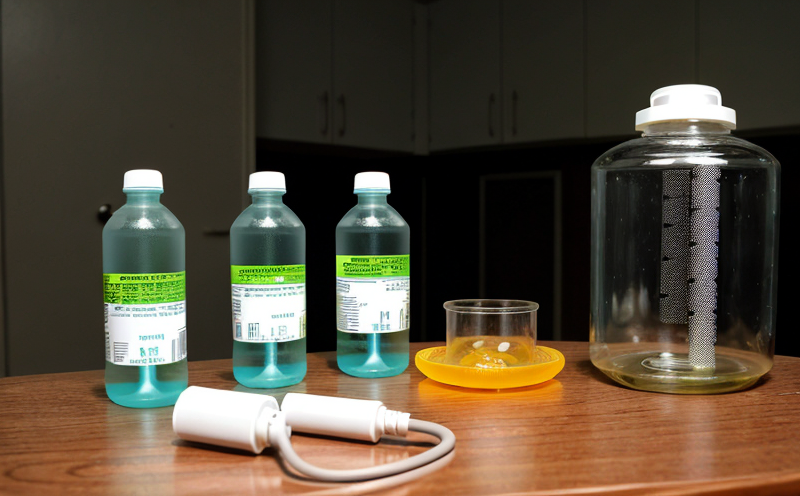ISO 13165-3 Uranium by Liquid Scintillation Test in Water
The ISO 13165 series provides internationally recognized standards for the determination of uranium and other radionuclides in water. The third part, ISO 13165-3, specifically addresses the measurement of uranium by liquid scintillation spectrometry (LSS). This method is highly sensitive and selective for detecting trace levels of uranium in various aqueous samples.
The test involves preparing water samples through filtration and acid digestion to release uranium into a suitable medium. The sample solution then undergoes treatment with reagents that convert the uranium to a form detectable by LSS. The resulting liquid scintillation cocktail is analyzed using a liquid scintillation counter, which measures light emission proportional to the amount of uranium present.
This technique provides accurate quantification of uranium in water samples down to parts per trillion (ppt). It is widely used for environmental monitoring and compliance with regulatory limits set by organizations such as the Environmental Protection Agency (EPA) and the World Health Organization (WHO).
The methodology ensures high precision through standardized procedures, including calibration checks and quality control measures. The test results are reported in mg/L or μg/L, depending on the concentration level.
The ISO 13165-3 standard is applicable to a wide range of water sources, from surface waters to industrial wastewater streams. Its application is crucial for identifying potential contamination issues and ensuring compliance with environmental regulations.
Quality managers and compliance officers rely on this method to ensure safe drinking water and protect ecosystems. R&D engineers use it to develop new purification technologies aimed at reducing uranium levels in water supplies. Procurement teams may employ the results of these tests to select suppliers who meet stringent quality standards for water treatment products.
The precision and accuracy offered by ISO 13165-3 make it an indispensable tool in environmental monitoring, particularly where low-level contamination is suspected or required by law.
Scope and Methodology
The scope of the ISO 13165-3 standard encompasses the determination of uranium at levels between 0.1 μg/L to 1 mg/L in water samples using liquid scintillation spectrometry.
- Sample preparation involves filtration, acid digestion, and reagent treatment to convert uranium into a form suitable for quantification by LSS.
- The sample is then introduced into the liquid scintillation cocktail, which contains solvents and additives that enhance light emission from the uranium.
- Data acquisition is performed using a liquid scintillation counter. This instrument records the intensity of emitted light to calculate uranium concentration.
The standard specifies detailed procedural steps for each stage of sample preparation and analysis. It emphasizes the importance of quality control, including regular calibration checks and blank runs to ensure accurate results.
ISO 13165-3 also provides guidelines on the selection of appropriate reagents and solvents based on the expected uranium concentration in the water sample. This ensures optimal performance of the LSS method under various conditions encountered in field applications.
The acceptance criteria for the test are stringent, requiring that measured concentrations fall within specified limits to be considered valid. Any deviations from these limits necessitate reanalysis or additional quality control measures.
Environmental and Sustainability Contributions
The ISO 13165-3 standard plays a critical role in environmental sustainability by providing reliable data for monitoring uranium contamination in water sources. This information is essential for identifying and addressing potential risks to human health and aquatic ecosystems.
By ensuring compliance with regulatory standards, this test helps prevent the spread of contaminated water into drinking supplies and natural habitats. The accurate measurement of uranium levels supports the development and implementation of effective remediation strategies when contamination is detected.
The methodology also contributes to sustainable practices by enabling continuous monitoring of water quality in industrial settings. This allows for proactive management of wastewater streams, reducing the likelihood of accidental releases that could harm the environment.
Furthermore, the use of ISO 13165-3 facilitates international collaboration on environmental issues related to uranium contamination. Standardized testing procedures ensure consistent results across different regions and laboratories, fostering trust in data exchange and joint initiatives aimed at global sustainability goals.
Use Cases and Application Examples
- Environmental Monitoring: Regular sampling and analysis of water sources using ISO 13165-3 help environmental agencies track uranium levels over time, identifying trends and potential areas for intervention.
- Regulatory Compliance: Industries involved in mining or manufacturing processes that generate wastewater containing uranium must comply with strict limits set by regulatory bodies. Testing ensures adherence to these standards.
- Public Health Protection: Monitoring of drinking water supplies helps ensure public health safety, especially in regions where natural uranium deposits are common.
- Research and Development: Researchers use ISO 13165-3 to evaluate the effectiveness of new purification technologies aimed at reducing uranium levels in water.
- Academia: Universities conducting research on environmental science and public health often employ this test as part of their curriculum to train students in advanced analytical techniques.
The versatility of ISO 13165-3 makes it a valuable tool across numerous sectors, from government agencies overseeing water quality to private companies focused on sustainable practices.





